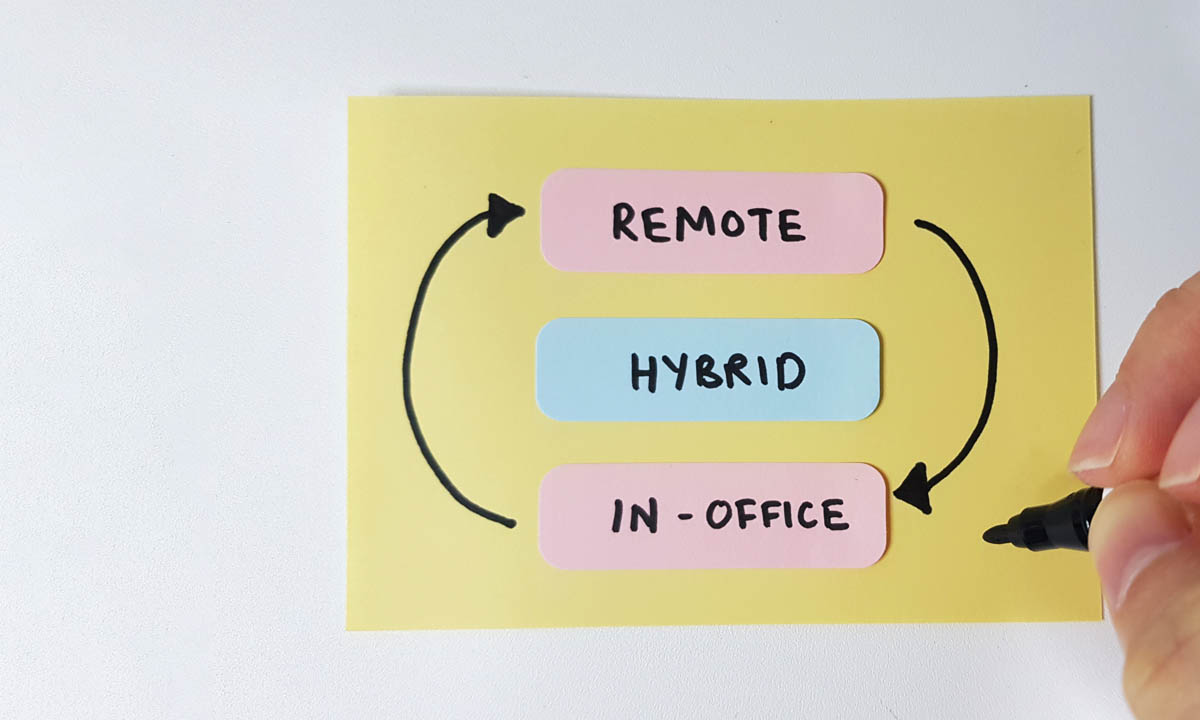Is hybrid the future of work? In today’s rapidly-changing landscape, many organizations are embracing the hybrid work model — with good reason. The combination of in-person and remote work can be a great way to increase employee engagement and productivity.
That is, if you know how to do it right.
Creating a successful hybrid work environment requires careful planning and consideration. In this article, we’ll explore several best practices you can use to support the success of hybrid teams.
What is a hybrid work model?
Before we dive into hybrid work best practices, it’s important to have a clear understanding of what it means to have hybrid workers. Generally speaking, the hybrid work model is any approach that combines remote work with office work.
For some companies, that means employees split their time evenly between working remotely and working on-site. For others, team members trade off who reports to the office each day and who works from home. And in the most flexible scenarios, organizations leave it up to employees to decide where, when and how they work best.
No matter how you choose to manage your hybrid workforce, the goal is the same: Find the best fit for each team and for the organization at large, whether that means adopting a split schedule, staggered schedule or open office policy — or a mix of all three.
8 hybrid work model best practices for long-term success
While there isn’t one specific model that will apply to every organization — especially since the concept of hybrid work is still evolving — several best practices will help ensure long-term viability.
1. Analyze your workforce
The first step to building a sustainable hybrid work model? Decide if it’s a good fit for your organization. That may sound obvious, but many organizations have learned the hard way that failing to analyze your workforce upfront can cause hybrid work to become toxic — the very opposite of what flexible work is meant to achieve.
How many jobs can be done remotely? How often do people need to report to the office? How likely are different hybrid schedules to impact productivity in positive or negative ways? If you’ve experimented with remote work in the past, what kinds of results did you see?
The answers to these questions may not only surprise you, but also help shape your hybrid work policies in unexpected ways. For example, after three years of experimenting with different models, HubSpot reported that hybrid sales teams are 28% more likely to outperform fully in-person or fully remote teams. The key is to find out what works best for your company first, before diving into the details.
2. Collect input from employees
It’s tempting to start by defining policies, such as which days to require people to work in the office and how to handle collaboration when people are working from home. But if you really want to see results, collaboration is key.
When employees and managers work together to determine what works best for each team, you can design a hybrid work model built for success. Rather than forcing people to design their work days around arbitrary rules, you can help optimize workflows based on their actual needs. That doesn’t mean you have to accommodate every employee preference. But by taking time to understand where, when and how teams are most productive, you can ensure your teams will be set up for long-term success.
3. Be fair
Not every role is suitable for hybrid work. According to Gallup, only five in 10 full-time U.S. employees have “remote-capable” jobs. The other half work in positions requiring them to physically report to work each day. Sometimes, this is driven by the industry. While most manufacturing employees have to work on site, people who work for tech companies may never need to leave their home offices.
But what happens when you have some employees who can do their jobs effectively from home, while others need to be in the office?
In these instances, fairness is key. Employees who are required to be on-site can become resentful of hybrid teams that operate with less rigidity. However, there are ways to balance the scales. Start by asking in-office employees what they need to be engaged and productive, and look for opportunities to create benefits especially for them. Commuter subsidies, flexible hours and four-day workweeks are just a few to explore.
4. Use the right technology
For a long time, companies focused on finding the best tools for supporting remote work. Now, the goal is to support work, period. It’s more important than ever to invest in hybrid workforce technology to help people do their best work, wherever and whenever it happens. For this reason, most modern workplaces already have some mix of video conferencing tools, project management software, team communication platforms and file sharing apps.
To truly optimize your technology stack for hybrid work, SaaS app visibility is crucial. By regularly evaluating which tools are being used by what teams — and which ones are going to waste — you can make more informed decisions. It’s one of the best methods for ensuring hybrid employees will have exactly what they need to be successful, no matter where they happen to be working on any given day.
5. Rethink your office space
Another bonus of the hybrid work model? You can take a fresh look at the office space you pay for. And that’s not a small benefit. Office space utilization is one of the best ways to correct vacancies and make the most of every real estate investment.
As your workforce settles into new hybrid work schedules, pay attention to which spaces they’re using. Are they coming to the office specifically to collaborate in conference rooms, or do they use individual workstations as well? Are they enjoying camaraderie over coffee in the break room, or spending time in deep work at desktops? As people develop new ways of working, this is the time to reimagine office setups and reevaluate designs.
6. Model a healthy work-life balance
Believe it or not, flexible work hours can often cause employees to work harder than they would in the office — or at least less efficiently. This is especially true in workplaces where managers still struggle with “productivity paranoia.” When leaders don’t trust their hybrid employees to be productive when working from home, people overcompensate by attending more Zoom meetings, sending more emails and sharing more documents — all just to give the appearance of working longer and harder. It’s called productivity theater, and it’s the enemy of true productivity.
Instead, leadership should model a healthy work-life balance. That means limiting communication to standard work hours, paying attention to workload distribution and regularly taking time off to refresh and refuel. Employees often model their own work habits after those of bosses and colleagues. And the tone you set matters — when employees believe their employer cares about their health and wellness, they’re 38% more engaged and 18% more likely to go the extra mile.
7. Regularly evaluate productivity data
Most importantly, don’t leave critical hybrid work decisions to chance. The most successful organizations are the ones that rely on workforce management software to understand where, when and how people do their best work.
As the hybrid work model continues to evolve, you’ll need insights to make data-driven decisions on everything from what your tech stack should look like to how the office should be designed. The sooner you start measuring and tracking these elements, the better positioned you’ll be to provide the best support possible.
8. Encourage open communication
Strong communication isn’t just a nice-to-have — it’s essential for hybrid work success. With employees distributed across locations and time zones, gaps in information or misalignment can quickly lead to confusion or disengagement.
One of the most effective hybrid work best practices is establishing clear communication norms. This includes defining when and how your team communicates — from scheduled stand-ups and asynchronous updates to guidelines for response times and platform use (e.g., Slack vs. email).
It’s also critical to give employees a voice. Use quick pulse surveys or feedback loops to understand how communication is landing, and adapt when needed. When communication flows freely in every direction, teams stay aligned, connected and productive — no matter where they work.
Create and manage a successful hybrid work model with ActivTrak
Yes, creating a successful hybrid work model is complex. And no, it won’t happen overnight. But with the right insights, you can overcome common challenges to create a hybrid work environment that truly works.
For an easy way to start implementing these best practices, sign up for a free ActivTrak account and request a demo for inside tips. We’ll show you how to analyze location-based productivity data, measure office utilization, evaluate your SaaS apps and more — all so you can create the best experience possible for employees, no matter where they work.





